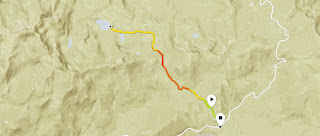Dale Matson
Click On Photographs To Enlarge
Hike Route
As Dirty Harry once said, “Every man has to know his
limitations.” I seems the older I get, the more I have to relearn and adjust
downwards, those limitations. Here is last years trip to the top. http://midsierramusing.blogspot.com/2016/07/kaiser-peak-hike-2016.html
I got an early start (6am) and hoped to get at least to a
point on the trail where I had a good view of the Central Sierra Nevada. And,
that is as far as I got. It was a little over 8,900’ when I turned back. Kaiser
Peak is about 10,300’. It was 4.5 hours up and 3 hours down total time out. The
trailhead temperature was 50 degrees to start and 80 degrees at the end! That
is pretty hot for 7,000’ in altitude. I was tired and the 1.5-hour drive back
down to Fresno was not easy either.
Anyway, I thought I would share some photographs I took this
year with my Sony A6000 and S/Z 16-70mm lens. They are less than optimal because there is considerable issues because of a forest fire that started near Mariposa and is still not contained. I wanted to travel as light as
possible and used my Mountain Hardwear Race Vest as a daypack. Here is a
photograph of me with it on at Devil’s Bathtub near Edison Lake. http://midsierramusing.blogspot.com/2014/06/a-race-vest-as-day-pack.html
I started with one full bottle of water and resupplied in
the creek in a meadow above College Rock on the way up and on the way down. I
suspect that there will be no water available for the entire hike by mid August.
If you do the hike then, you will need to carry about three liters of water with
you.
Early Morning D&F Pack Station
China Peak Ski Area
Fading Snow Plant
Huntington Lake Full Of Water
Mama Grouse
Grouse Chick
The Steep Climb Above The Meadow
Trail Leading To Next False Summit
Banner Peak Near Mammoth CA
Edison Lake Center Below Vermillion Cliffs
George Lake You Can Get There Via The Twin Lakes Trail
https://midsierramusing.blogspot.com/2013/08/potter-pass.html

https://midsierramusing.blogspot.com/2013/08/potter-pass.html

Mt Goddard Center
Ubiquitous Marmots







































































